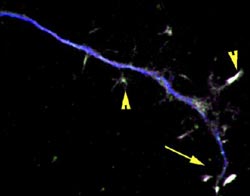Stay-at-home transcription factor prevents neurodegeneration

A JCB study shows how the protein CNTF activates the transcription factor STAT3 (green), which lingers in the axon (blue) and helps stabilize microtubules by inhibiting a protein called stathmin (magenta). STAT3 and stathmin colocalize in axonal branch points (arrowheads) and growth cones (arrow).<br><br>Credit: Selvaraj, B.T., et al. 2012. J. Cell Biol. doi:10.1083/jcb.201203109<br>
In Lou Gehrig's Disease (ALS) and other neurodegenerative diseases, nerve cells usually die in stages, with axons deteriorating first and the cells themselves perishing later. Axon degeneration may represent a turning point for patients, after which so much nerve damage has accumulated that treatments won't work.
Researchers have tested several proteins for their ability to save axons. One of these molecules, CNTF, rescues axons in rodents and extends their lives. But it caused severe side effects in patients during clinical trials. “Acting on the same pathway but farther downstream could be an ideal way to improve the situation for motor neuron disease” and possibly for other neurodegenerative diseases, says senior author Michael Sendtner from the University of Wuerzburg in Germany.
To discover how CNTF works, Sendtner and his colleagues studied mice with a mutation that mimics ALS. The researchers found that CNTF not only prevented shrinkage of the rodents' motor neurons, it also reduced the number of swellings along the axon that are markers of degeneration. It is known that CNTF indirectly turns on the transcription factor STAT3, so the researchers wanted to determine if STAT3 is behind CNTF's protective powers. They tested whether CNTF helps motor neurons that lack STAT3 and discovered that, in the mutant mice, axons lacking STAT3 were half as long as those from a control group after CNTF treatment
Once it has been activated, STAT3 typically travels to the nucleus of the neuron to switch on genes. But the researchers were surprised to find that most of the axonal STAT3 did not move to the nucleus and instead had a local effect in the axon. Specifically, the team found that activated STAT3 inhibited stathmin, a protein that normally destabilizes microtubules. When the team removed stathmin in motor neurons from the mutant mice, the axons grew at the same rate as axons from normal mice but didn't elongate any faster after doses of CNTF. These results indicate that CNTF mainly stimulates axon growth by thwarting stathmin and suggests that drugs to block stathmin could slow neuron breakdown in patients with neurodegenerative diseases.
About The Journal of Cell Biology (JCB)
JCB is published by The Rockefeller University Press. All editorial decisions on manuscripts submitted are made by active scientists in conjunction with our in-house scientific editors. JCB content is posted to PubMed Central, where it is available to the public for free six months after publication. Authors retain copyright of their published works, and third parties may reuse the content for non-commercial purposes under a creative commons license. For more information, please visit www.jcb.org.
Selvaraj, B.T., et al. 2012. J. Cell Biol. doi:10.1083/jcb.201203109
Media Contact
All latest news from the category: Life Sciences and Chemistry
Articles and reports from the Life Sciences and chemistry area deal with applied and basic research into modern biology, chemistry and human medicine.
Valuable information can be found on a range of life sciences fields including bacteriology, biochemistry, bionics, bioinformatics, biophysics, biotechnology, genetics, geobotany, human biology, marine biology, microbiology, molecular biology, cellular biology, zoology, bioinorganic chemistry, microchemistry and environmental chemistry.
Newest articles

Superradiant atoms could push the boundaries of how precisely time can be measured
Superradiant atoms can help us measure time more precisely than ever. In a new study, researchers from the University of Copenhagen present a new method for measuring the time interval,…

Ion thermoelectric conversion devices for near room temperature
The electrode sheet of the thermoelectric device consists of ionic hydrogel, which is sandwiched between the electrodes to form, and the Prussian blue on the electrode undergoes a redox reaction…

Zap Energy achieves 37-million-degree temperatures in a compact device
New publication reports record electron temperatures for a small-scale, sheared-flow-stabilized Z-pinch fusion device. In the nine decades since humans first produced fusion reactions, only a few fusion technologies have demonstrated…





















